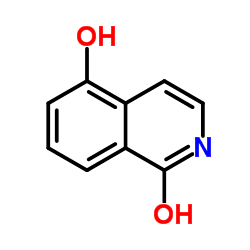1,5-Isoquinolinediol

1,5-Isoquinolinediol structure
|
Common Name | 1,5-Isoquinolinediol | ||
|---|---|---|---|---|
| CAS Number | 5154-02-9 | Molecular Weight | 161.157 | |
| Density | 1.4±0.1 g/cm3 | Boiling Point | 501.1±30.0 °C at 760 mmHg | |
| Molecular Formula | C9H7NO2 | Melting Point | 270-275 °C | |
| MSDS | Chinese USA | Flash Point | 256.8±24.6 °C | |
| Symbol |

GHS07 |
Signal Word | Warning | |
|
Inhibitors of poly (ADP-ribose) synthetase protect rat cardiomyocytes against oxidant stress.
Cardiovasc. Res. 41(1) , 126-34, (1999) Inhibitors of poly (ADP-ribose) synthetase (PARS) activity reduce the infarct size caused by regional myocardial ischaemia and reperfusion in the rabbit and rat in vivo. The mechanism of action of these inhibitors is unclear. Here we investigate the effects o... |
|
|
Prevention of the degeneration of human dopaminergic neurons in an astrocyte co-culture system allowing endogenous drug metabolism.
Br. J. Pharmacol. 172 , 4119-32, (2015) Few neuropharmacological model systems use human neurons. Moreover, available test systems rarely reflect functional roles of co-cultured glial cells. There is no human in vitro counterpart of the widely used 1-methyl-4-phenyl-tetrahydropyridine (MPTP) mouse ... |
|
|
Modulation of the poly (ADP-ribose) polymerase inhibitor response and DNA recombination in breast cancer cells by drugs affecting endogenous wild-type p53.
Carcinogenesis 35(10) , 2273-82, (2014) Synthetic lethal interactions between poly (ADP-ribose) polymerase (PARP) and homologous recombination (HR) repair pathways have been exploited for the development of novel mono- and combination cancer therapies. The tumor suppressor p53 was demonstrated to e... |
|
|
Disrupted ADP-ribose metabolism with nuclear Poly (ADP-ribose) accumulation leads to different cell death pathways in presence of hydrogen peroxide in procyclic Trypanosoma brucei.
Parasit. Vectors 9 , 173, (2016) Poly(ADP-ribose) (PAR) metabolism participates in several biological processes such as DNA damage signaling and repair, which is a thoroughly studied function. PAR is synthesized by Poly(ADP-ribose) polymerase (PARP) and hydrolyzed by Poly(ADP-ribose) glycohy... |
|
|
Inhibition of poly-ADP ribose polymerase enzyme activity prevents hyperglycemia-induced impairment of angiogenesis during wound healing.
Wound Repair Regen. 22(5) , 666-70, (2014) We previously reported a zebrafish model of type I diabetes mellitus (DM) that can be used to study the hyperglycemic (HG) and metabolic memory (MM) states within the same fish. Clinically, MM is defined as the persistence of diabetic complications even after... |
|
|
Effects of inhibitors of poly(ADP-ribose) synthetase activity on hypotension and multiple organ dysfunction caused by endotoxin.
Shock 10(1) , 13-9, (1998) The nuclear enzyme poly(ADP-ribose) synthetase (PARS) is activated by DNA strand breakage, caused, for example by nitric oxide (NO), peroxynitrite, or oxygen-derived free radicals. Activation of PARS can cause intracellular energy depletion and cell death in ... |
|
|
Effects of inhibitors of the activity of poly (ADP-ribose) synthetase on the organ injury and dysfunction caused by haemorrhagic shock.
Br. J. Pharmacol. 128(6) , 1339-45, (1999) 1 Poly (ADP-ribose) synthetase (PARS) is a nuclear enzyme activated by strand breaks in DNA, which are caused by reactive oxygen species (ROS). Here we investigate the effects of the PARS inhibitors 3-aminobenzamide (3-AB), nicotinamide and 1,5-dihydroxyisoqu... |
|
|
The effect of poly (adenosine diphosphate-ribose) polymerase inhibitors on biochemical changes in testicular ischemia-reperfusion injury.
J. Urol. 169(5) , 1870-3, (2003) Poly (adenosine diphosphate [ADP]-ribose) polymerase inhibitors have been used successfully to decrease ischemia-reperfusion injury in several organ systems. We evaluated the efficacy of poly (ADP-ribose) polymerase inhibitors on biochemical changes in testic... |
|
|
PARP inhibition reduces acute colonic inflammation in rats.
Eur. J. Pharmacol. 563(1-3) , 216-23, (2007) Poly(ADP-ribose) polymerases (PARP) comprise a family of enzymes which catalyse poly(ADP-ribosyl)ation of DNA-binding proteins. Multiple researches indicate the importance of PARP in promoting cell recruitment and thereby inducing organ injury in various form... |
|
|
Inhibitors of poly (ADP-ribose) polymerase ameliorate myocardial reperfusion injury by modulation of activator protein-1 and neutrophil infiltration.
Shock 23(3) , 233-8, (2005) During myocardial reperfusion injury, oxidative stress induces DNA damage and activation of the nuclear enzyme poly(ADP-ribose) polymerase-1 (PARP-1), resulting in cardiovascular dysfunction. In this study, we investigated the biological effects and the molec... |